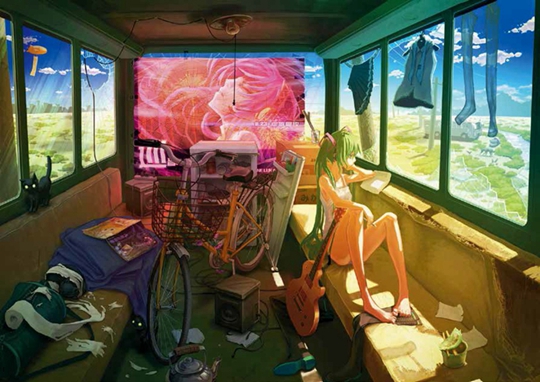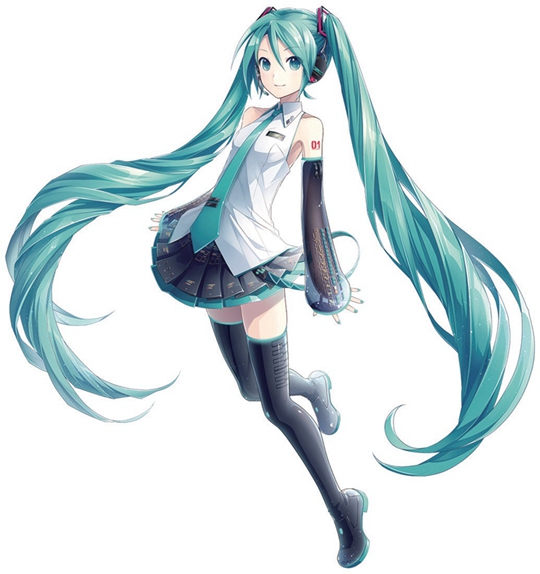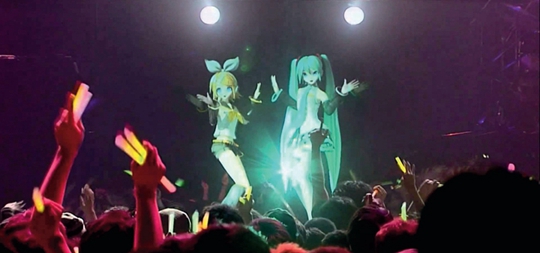BACK TO THE CROWD-SOURCED FUTURE OF HATSUNE MIKU
| July 1, 2015 | Post In 2015年6月号

In 2007 we knew Hatsune Miku only as a virtual pop star program. By 2010 we began to realize that a huge number of people had produced derivative work, marking a development in both the medium and in the languages of cosplay culture. Anime and manga generally rely on visual images to connect communities. Fans of Gundam and Neon Genesis Evangelion started out as fans of the original work, including the overarching story and individual characters. Fandom was traditionally followed by identification, so communities were limited in scope. But Hatsune Miku is a character with no story, and no fixed visual image—the company gave her only a basic outline. Derivative characters are wide-ranging. Hatune Miku is a platform that allows anyone to join in, connecting to other people and roles. Derivative characters accompany new music and online discussions. Anyone can be Hatsune Miku.
Western modernity in art allows for the introduction of new ideas against the background of a stable history of art, backed by the power of the art market, and so there is anxiety in certain quarters about localization, about art being limited to a certain discourse. Like modernity, Hatsune Miku is a tool, but she emerges from communication technology and the universalism of anime and manga; in this way it may be more capable of transcending cultural hegemony than western visual language. Each frame of animation is drawn to act on the reader’s feelings, then uses this emotion as input.
Universalism must have a basis, relying on the tight flow of discourse within society—an idea can only gain universal acceptance following rigorous examination. When western ideas first migrated to Asia there was often a lack of sufficient debate, meaning that universalizing ideas were promoted primarily through political and economic forces. Some of the most heated discussions recently have revolved around globalization and localization, leaving us looking for a way to intensify discourse and communication, to focus on important topics that affect us without being limited to the dichotomy of global and local. Perhaps we could look to the enthusiasm within the Hatsune Miku community, which far exceeds that in contemporary art.

Conceptual art opposed the hegemony of the image because the picture creates an aesthetic and sensory threshold. Conceptual art dealt with the transformation of ideas, opening up new visual, aural, or spatial experiences. But today the legacies of conceptual art have encountered setbacks, tending toward the over-interpretation of material and intervention in society. Even if an artist’s work consciously relates to real life, for most viewers the accessibility threshold is high—background information remains necessary. I believe that sound and music can be more direct methods of influence and communication. Of course, Hatsune Miku is more complex in that it is not a purely vocal or musical creation, but still has the tone of popular music.
Social connections used to rely on ideas and values that supported the cohesion of the group—interpersonal relationships were built on the identification of an ethical relationship. Today it is difficult to rely on immediate and extended family networks, as well as school peer groups. In post-globalization contemporary art, we encounter images and sounds before we even encounter the world. Human relationships depend on the systemic languages provided by technological platforms, which provide the chance to form social networks and, to a great extent, determine the forms of these networks. Human relationships formed online are performative, and the content of communication becomes more specialized and increasingly fragmentary. Hatsune Miku appears at this juncture: every member of its community participates in a highly aestheticized manner, communicating via creativity. This must be an active performance in which individuals simultaneously act as each other’s audience, giving spontaneous criticism. Aesthetics challenges the prevailing ethics.
Contemporary art offers some insight into technology and language, including the use of software like Hatsune Miku. It goes far beyond the realm of commercial research and development, and produces stronger interaction with the consumer. But this seems an ever more distant ideal. Now, in the extremely commercialized world of Japanese anime and manga, derivative work can be permitted to exist when it is made for non-commerical reasons, making consumer groups more active and diverse, and in turn lengthening the original work’s value and life expectancy in the marketplace.

When contemporary art confronts the issue of derivative work, the focus is generally on sharing experiences of the everyday. Art has an established market system, determining value through galleries and other players, and it would be difficult to relax this calculation. Different fields of production and circulation have specific ways of conducting and regulating transactions. It would be difficult to ask the Hatsune Miku group to consider the problems of contemporary art. A purely commercial technology company is bound by its own philosophy, and may be even less flexible than contemporary art.
In a capitalist system there is a process of fetishization and objectification, but people still find ways to participate in these flows. Something like Hatsune Miku relates to ideas in a different way, and is not so absolutely ideologically opposed to objectification—it uses the senses stimulated by objectification as a form of communication. Hatsune Miku is not a product, but a means of production. Can contemporary art create tools, or can it only produce works of art? If it is very useful or influential, can a tool become a work of art?
Contemporary art can look to Hastune Miku for its sense of collective creativity—collective not in the sense of being homogeneous, and not based in identity, but rather in that each individual can create independently within a mutually constituted network. With Hatsune Miku, social and commercial structures cannot be separated—the linguistic or media critiques of contemporary art do not apply. In the end, experiments in economic format will make it even to contemporary art.
(Based on conversations with Song Yi, translated by Vanessa Nolan)

